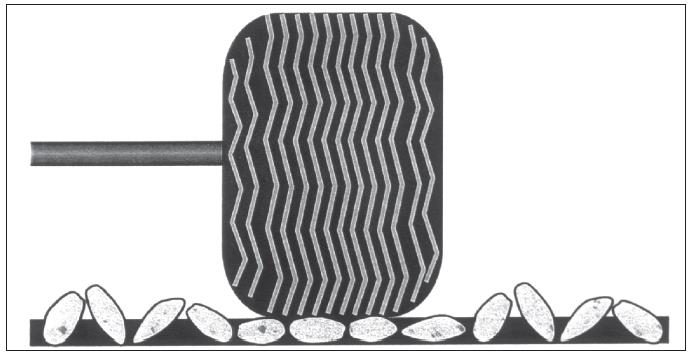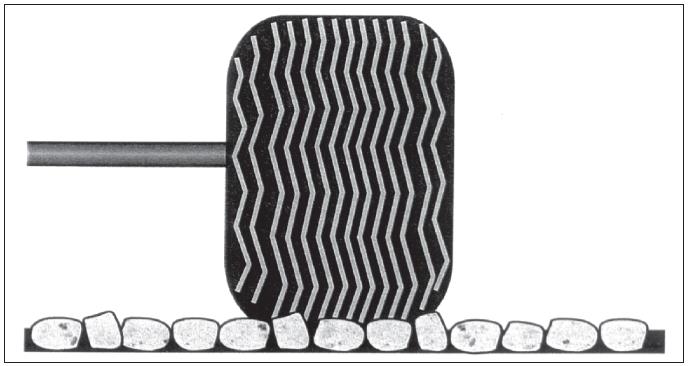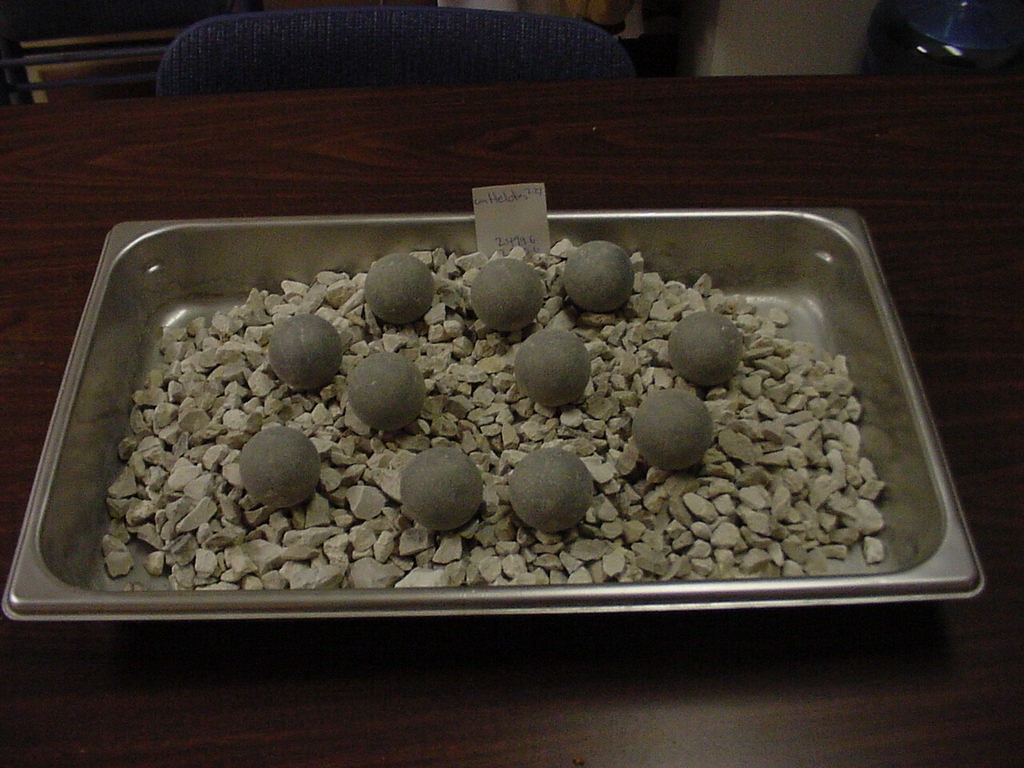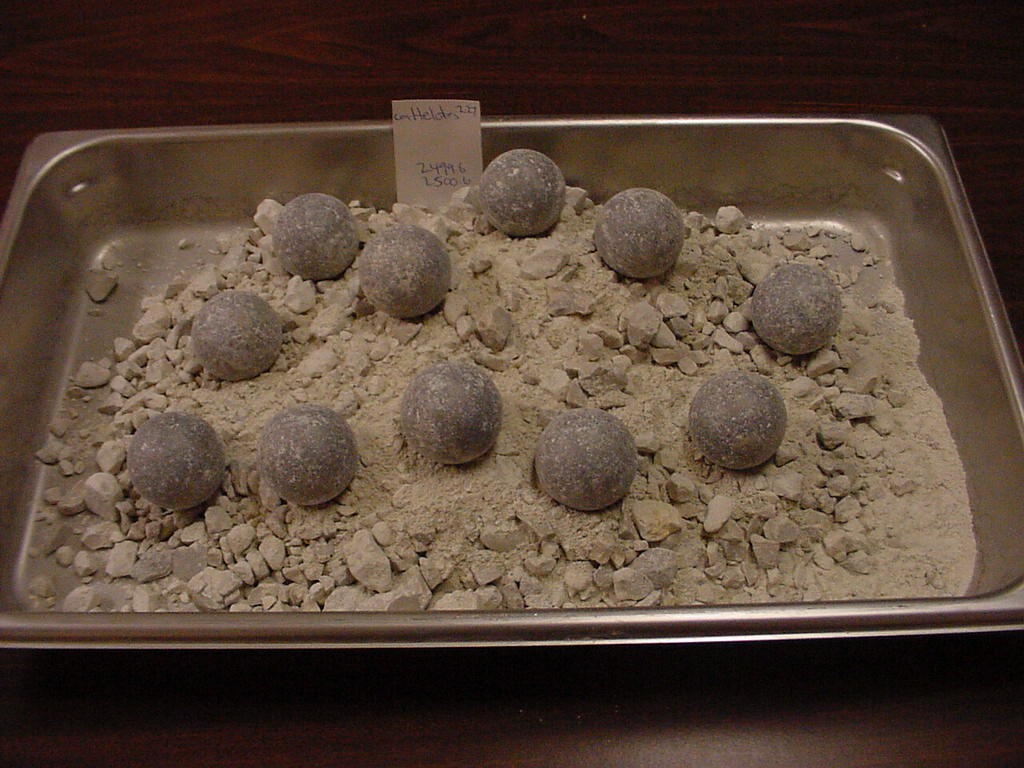Section 3: Selection of Aggregate
Anchor: #i1001915General
The aggregate in a seal coat or surface treatment serves the following functions:
- Anchor: #ICFKYVSY
- It is resistant to the abrasion of moving wheel loads and transfers the wheel load to the underlying layers. Anchor: #UTJUGIAF
- It provides a skid-resistant surface. Anchor: #XSJHQIYQ
- It may provide light-reflecting qualities. Anchor: #LHLNVPVF
- It may provide a different texture or color to distinguish areas, such as shoulders and travel lanes.
There are two broad categories used to describe the aggregates used in Texas for seal coats and surface treatments: natural and synthetic.
Natural Aggregates
- Anchor: #GUVOXOOK
- Crushed gravel – natural gravel that has been crushed to change the particle shape from round to angular and the surface from smooth to rough. Anchor: #FKMIAMJX
- Crushed stone – large stone or pieces of bedrock that have gone through a series of crushing processes. In Texas, this stone is predominantly limestone, but also includes sandstone. Anchor: #KLOSWAKW
- Natural limestone rock asphalt – limestone rock asphalt is a limestone that is naturally impregnated with asphalt.
Synthetic Aggregates
- Anchor: #AMADKSWK
- Lightweight aggregate – expanded shale, clay, or slate produced by a rotary kiln method. Due to its low specific gravity (or light weight) it tends to cause less windshield and vehicle damage. It also has excellent skid-resistant properties. Anchor: #OADBGDSQ
- Crushed slag – produced as a by-product of steel production. When crushed and used as a seal coat aggregate, it can give good wear and skid resistance.
Factors of Aggregate Affecting Performance
Maximum Particle Size and Gradation
It is desirable that aggregates used for seal coats and surface treatments consist of essentially one size of aggregate. If all of the aggregate particles are about the same size, embedment depth will be the same for each particle contributing to successful performance of the seal coat. Very fine aggregate particles are likely to become submerged in the asphalt. For practical purposes, specifications allow some oversize and some undersize particles. TxDOT Standard Specification Item 302, Aggregates for Surface Treatments, describes the size and gradation requirements for aggregates used in seal coats and surface treatments.
The maximum particle size refers to the largest size allowable. For example, according to the specification, a Grade 3 aggregate has a maximum particle size of 5/8 inch, and a Grade 4 has a maximum particle size of ½ inch. A successful seal coat is more generally achieved when larger size cover aggregate is employed. This is because the larger aggregates are less sensitive to small variations in binder application rate than when smaller cover aggregates are used. Larger size aggregates, however, also tend to create more tire/pavement noise and are more likely to cause vehicle damage when dislodged from the pavement.
a. Graded aggregates make it difficult to achieve consistent embedment depth.�
(b) Single size gradation produces consistent results.�
Figure 3-4. Gradation comparisons�
Cleanliness. If aggregate is excessively dirty or dusty, asphalt binder will not be able to hold the aggregate particles securely in place. The asphalt will stick to the coating of dirt or dust, and with traffic the aggregate particles will dislodge. The aggregate must also be free of foreign matter such as leaves, grass, sticks, and lumps of clay or dirt. Cleanliness is measured by the Deleterious Material Test (Tex-217-F, Part I) and the Decantation Test (Tex-406-A).
Shape. The ideal shape of aggregate particles for seal coats and surface treatments is a shape that is as near to cubical as possible. When the seal coat aggregate is in place, traffic gradually orients the particles until each is lying on its flattest side with its thinnest dimension generally perpendicular to the roadway surface. (Figure 3-5).
Figure 3-5. Effect of aggregate shape.�
The average thickness of the seal coat when the aggregate particles attain this ultimate position is equal to the overall average of the thinnest dimensions of the stone particles. This overall average of the smallest dimensions of the particles is referred to as its Average Least Dimension (ALD). This ALD is important for two reasons:
- Anchor: #SLQUDCST
- It can control the quantity of cover stone and asphalt binder that should be applied. Anchor: #QWXCPQPS
- ALD values can differ widely for any given maximum aggregate size due to particle shape.
The ALD will be discussed in more detail in Chapter 4. TxDOT specifications (Item 302, Aggregates for Surface Treatments) refer to the Flakiness Index, as measured in Test Method Tex-224-F, to control the aggregate shape. The lower the Flakiness Index, the more cubical the aggregate is.
Angularity is also an important shape characteristic (Figure 3-6). The more angular the stone, the better the interlocking because there are many points of contact. Angularity for crushed gravel is measured by the Coarse Aggregate Angularity Test (Tex-460-A, Part I).
0% Crushed / 100% with 2 or more crushed faces�
Figure 3-6 Percent crushed fragments in gravels.�
Toughness. The aggregate must be able to resist abrasion and degradation. If the aggregate surfaces degrade under traffic, particles may break apart, broken pieces may dislodge (causing windshield damage), and flushing will likely result. These aggregate properties are measured by the Los Angeles Abrasion Test (Test Method Tex-410-A) and Magnesium Sulfate Soundness Loss (Test Method Tex-411-A).
Aggregate Absorption (uncoated). All aggregates are somewhat porous and will absorb water as well as asphalt. Limestone and lightweight aggregates are more absorptive than aggregates such as gravel. The amount of binder applied to the roadway should compensate for absorption into the cover aggregate. More absorptive aggregates also tend to have a higher affinity for asphalt (adhere better to the asphalt binder).
When aggregates are used that have a lower affinity for asphalt, extra care should be taken with respect to dryness and cleanliness of the aggregate, dry roadway surface, and dry weather.
Figure 3-6. Aggregate before and after Los Angeles Abrasion test.�
Anchor: #i1002052Precoated Aggregate
Aggregates may be precoated with asphalt binder to address the following issues:
- Anchor: #FSWLXLOI
- To maximize adhesion of the aggregate to asphalt cement binders Anchor: #LYJQDBWU
- To reduce or minimize the accumulation of dust on the surface of the aggregate Anchor: #LSSJJXUX
- To address the aggregate absorption quality of the aggregate Anchor: #QKMKXKRA
- To improve color contrast between striping and roadway surface.
Asphalt binders for precoating aggregates can be emulsions or asphalt cements. The target value of precoating material typically varies from 0.5 to 1.5 percent (0.5 to 3.0 percent for lightweight aggregate), by weight, of residual binder on the aggregate.
When the seal coat binder is to be an asphalt cement, precoating of the aggregate is recommended to maximize adhesion and reduce the adverse effect of dust. In general, precoated aggregate is not recommended when asphalt emulsions are used.
Anchor: #i1002092Criteria for Determining Surface Aggregate Classification
The aggregates selected for use in seal coats or surface treatments should provide sufficient friction to satisfy the frictional demands of the roadway. The TxDOT Wet Weather Accident Reduction Program (WWARP) provides methods to ensure that pavements with good skid-resistant characteristics are constructed. The guidelines address three separate but interrelated aspects of pavement friction safety: accident analysis, aggregate selection, and skid testing.
For complete details on aggregate selection, refer to the TxDOT WWARP in the Pavement Design Manual. The designer should consider the guidelines presented in the WWARP and, using engineering judgment, determine the overall frictional demand of the roadway surface. TxDOT Standard Specification Item 316, Seal Coats, states “…. unless otherwise shown on the plans, furnish aggregate with a minimum “B” (i.e., A or B is permitted) surface classification.”
Anchor: #i1002110Cost Considerations
Another factor in selecting the aggregate is the cost of the material. Consider the desired life of the seal coat before deciding on the type and classification of aggregate. If the road is to be reconstructed/resurfaced in the near future or if the seal coat is to be applied as an underseal for a hot mix asphalt concrete (HMAC) overlay, higher quality/more expensive aggregate may not be necessary.
Some aggregates may not be available from local sources and will be more expensive due to transport costs. Aggregates such as lightweight aggregates and limestone may be more desirable due to certain qualities; but these aggregates may not be available from local sources.
Anchor: #i1016066Bicyclist Considerations
Throughout the state there are many routes that bicyclists frequently travel and need to be considered for safety and ease of use by evaluating different size aggregates. Coordination with the District Seal Coat Coordinators and District Bicycle & Pedestrian Coordinators is key in identifying these high traffic bicycle routes to better accommodate others using this mode of transportation.
Past research has shown that smoother surfaces are desirable for bicyclists. When placing a seal coat as a final driving surface, consider one of the following low cost options to provide an improved riding surface for bicycles:
- Anchor: #MOFUGCLQ
- Use a smaller seal coat aggregate, Anchor: #URCLQECD
- Use a smaller seal coat aggregate on the shoulders, Anchor: #RHVQSUWB
- Use fog seal on existing seal coated shoulders rather than a new seal coat, or Anchor: #VNTMRYKT
- Use smaller aggregate for the top course of multiple course seal coats.
NOTE: In areas of high bicycle traffic where skid values are an issue, consider using a hot-mix overlay in that segment.






